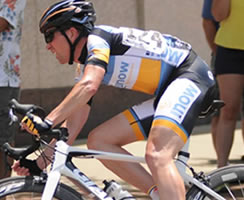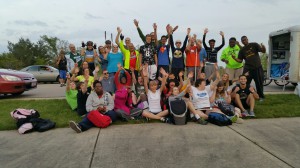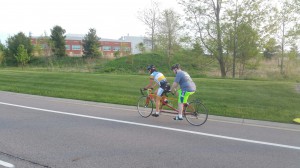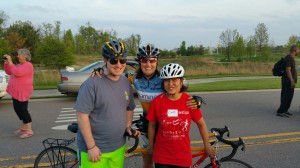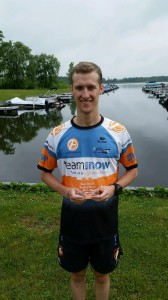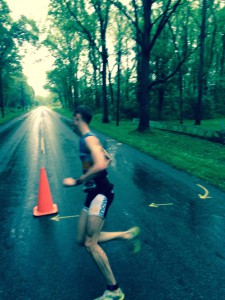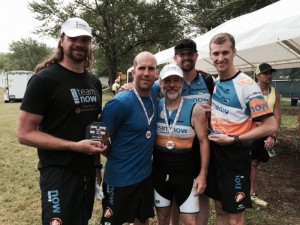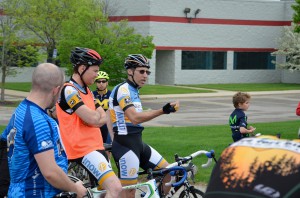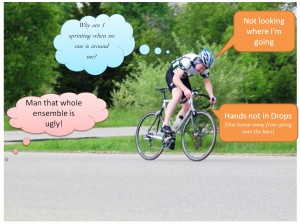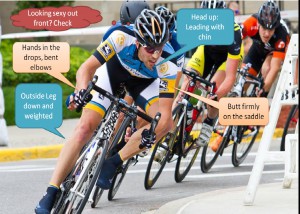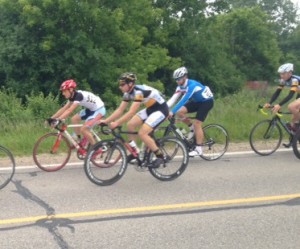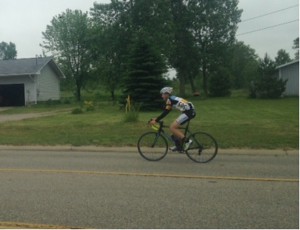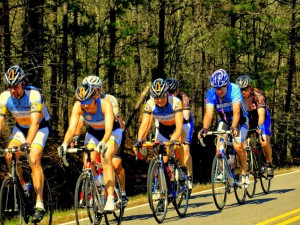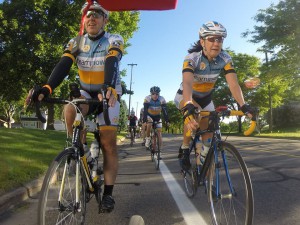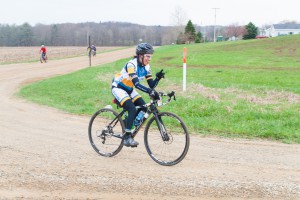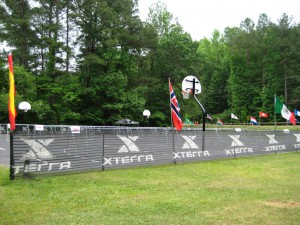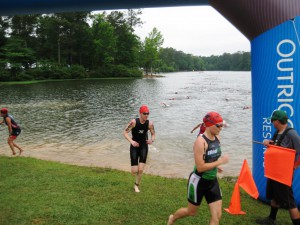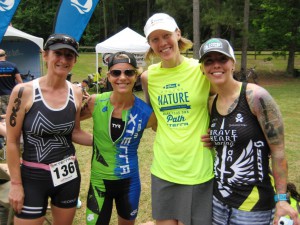By Chris Gottwald, Team OAM Now Cyclist
Want to know what it’s really like to race a Criterium at the Pro / Cat I level? You might be surprised!
After 24 years of racing in the elite ranks, one of the most popular questions is what is like to perform at this level? The reality is that there are several different types of riders, each one with a different experience. One of the more amusing parts of my career is that I am a very different breed and, as such, I have to ride a very different type of race than other riders.
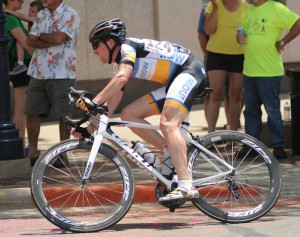 First off, I am small. How small? About 135 lbs on a HEAVY day and about 5’9” tall… all of it legs (34” inseam). I am often mistaken as a female ballet dancer rather than a World Record holding bicycle racer. Some of my nick names include: half pint, spider, and man-child. Ironically though, it makes me fast, even more so when the course points upward. In the typical American-style Criterium race though, I just plain old suffer like a dog.
First off, I am small. How small? About 135 lbs on a HEAVY day and about 5’9” tall… all of it legs (34” inseam). I am often mistaken as a female ballet dancer rather than a World Record holding bicycle racer. Some of my nick names include: half pint, spider, and man-child. Ironically though, it makes me fast, even more so when the course points upward. In the typical American-style Criterium race though, I just plain old suffer like a dog.
Take for example last season, at the Gaslight Criterium, I got another huge piece of humble pie. My great friends, and team mates, Cory Stange (who came in 1st in the Michigan Race Series) finished 6th and Dan Yankus finished close behind at 8th. As for me? I was 23rd. For the typical spectator, I am sure my performance looked average. The truth is though my average power was the highest I had seen in quite some time while racing: 257 Watts for 90 minutes. Truth be told, I can produce a little over 270 watts for 90 minutes thanks to the phenomenal coaching of Mark Olson, however, remember: 135 lbs. and 5’9”.
Here’s what it feels like:
Every time we headed up the home stretch, and around the back stretch, most guys easily accelerated to over 30MPH using their huge legs, that look more like they belong on a draft horse. My only option is to dig deep, producing over 500 watts 2 times a lap for 90 minutes. Once the pace settles, I try to rest a little, but since speed is a function of power I don’t really get much. I suffer to accelerate like the bigger guys. The headwind on the back stretch and the tail wind on the front stretch gave the bigger guys the advantage too! I had to wonder if I’d ever get a break?
Typically, my power ranks right up there to stay in a race. If I look at my power delivery over a race there are amazing highs and peaks. So, even though I’m using a lot more to create that power, a bigger guy using that same amount of power can’t cycle through those peaks as many times as I can. I can do more and I can recover. I can hang in a very long time. For example, at The Herman Miller Crit, 96 guys started on cobblestone, in the rain, and only 35-40 finished. It’s a tough race, but I can do that, which is surprising to many with my size. They all wanted to know how I do it.
If I have it my way, I’ll make the break, ride smart in the break, throw in a few efforts to wear the big guys down and maybe beat a few guys at the line. I try to minimize how many matches I burn making the race and pedal a little deeper in the turns. It’s all about trying to be efficient. I can corner pretty well to due to my size and flexibility. The eventual Gas Light Crit winner, David Williams, rode my kind of race. Smaller riders like us have to ride differently; we have to time things exactly right. His move was brilliantly timed. There was a group of riders ahead of me, who didn’t have much of a lead, and I thought I’d wait to see what happened. I didn’t see either of the Williams brothers around, so I pulled hard to join the group. When I finally pulled out in front of them, Dave Williams came from behind to counter and I was spent. Unfortunately, it was too late for me to do anything. I made the early mistake by putting in a herculean effort, only to find both Williams brothers on my wheel. When they countered I had simply dug too deep and could not answer the call. It was a huge mistake. Never ever put in an effort so tough that you cannot go with the counter, because that’s when the break goes and it did.
The Gas Light had a happy ending though. The men’s elite team really clicked last year. We all know each other like brothers and we know each other’s strengths and weaknesses. Dan and Cory both knew that was about all I had for the moment and smartly covered the move. A big thanks to both of them!
In closing what’s it like to race at this level? Quite a blessing! It’s unimaginable to most and just plain crazy to others. To me, it’s the way I roll and what I feel called to do. There is no sign of me slowing down any time soon. I simply love to race. As for another pack finish at Gas Light…I learned another lesson. Hope to see you out on the road soon. Thanks for reading!
The post The Life of a 135-Pounder appeared first on Team Athletic Mentors.
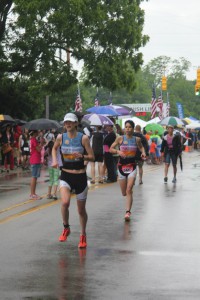 The morning of the Grand Rapids Triathlon started out at 4 am for many members of the Team OAM Now. Like last year, it was raining steadily as athletes set up the transition area. For those of you who have never had the distinct pleasure of setting up transition in the rain, it really is an experience. Forget about using electrical tape to attach gels to your top tube – nothing sticks. Your towel and shoes will be soaked if you don’t have a trash bag to cover them. If your helmet has an eyeshield, anticipate it being wet and impossible to see out of. I’ll admit, after my sub-par performance at Big Fish Triathlon in Ortonville two weeks prior, where I did the Olympic aquabike in 45 degrees and pouring rain, I was less than thrilled for another rainy day aquabike. At least my hands weren’t numb as I got into my wetsuit this time!
The Grand Rapids Triathlon is one of the biggest tris in the state. Team OAM Now/Athletic Mentors is one of the sponsors of this race. As such, we had a tent at the expo the day before the race. It was great to catch up with teammates before race day. As we handed out hot/cold packs, granola bars, and fliers, I learned that most of the multisport team racing would be doing the half-iron distance. The more the merrier, right? Plus, that meant that I would probably see some friendly faces as I entered the water in the first wave at 7 am. However, as I lined up in the corral to get in the water, I didn’t see any of my teammates. No worries though – I hung out with some friends from Grand Valley State University, where I did my undergrad, and hoped everyone from Team OAM Now was in place and ready to race!
The swim was uneventful and I hoped that, like last year, it would no longer be raining when I hit the road on the bike. To my minor disappointment, it was still sprinkling. The roads were, for the most part, decently drained and I only had to weave around several large puddles. I felt good on the bike though and, with the exception of needing to wipe off my eyeshield every mile or so, I wasn’t hampered by the rain.
The morning of the Grand Rapids Triathlon started out at 4 am for many members of the Team OAM Now. Like last year, it was raining steadily as athletes set up the transition area. For those of you who have never had the distinct pleasure of setting up transition in the rain, it really is an experience. Forget about using electrical tape to attach gels to your top tube – nothing sticks. Your towel and shoes will be soaked if you don’t have a trash bag to cover them. If your helmet has an eyeshield, anticipate it being wet and impossible to see out of. I’ll admit, after my sub-par performance at Big Fish Triathlon in Ortonville two weeks prior, where I did the Olympic aquabike in 45 degrees and pouring rain, I was less than thrilled for another rainy day aquabike. At least my hands weren’t numb as I got into my wetsuit this time!
The Grand Rapids Triathlon is one of the biggest tris in the state. Team OAM Now/Athletic Mentors is one of the sponsors of this race. As such, we had a tent at the expo the day before the race. It was great to catch up with teammates before race day. As we handed out hot/cold packs, granola bars, and fliers, I learned that most of the multisport team racing would be doing the half-iron distance. The more the merrier, right? Plus, that meant that I would probably see some friendly faces as I entered the water in the first wave at 7 am. However, as I lined up in the corral to get in the water, I didn’t see any of my teammates. No worries though – I hung out with some friends from Grand Valley State University, where I did my undergrad, and hoped everyone from Team OAM Now was in place and ready to race!
The swim was uneventful and I hoped that, like last year, it would no longer be raining when I hit the road on the bike. To my minor disappointment, it was still sprinkling. The roads were, for the most part, decently drained and I only had to weave around several large puddles. I felt good on the bike though and, with the exception of needing to wipe off my eyeshield every mile or so, I wasn’t hampered by the rain.
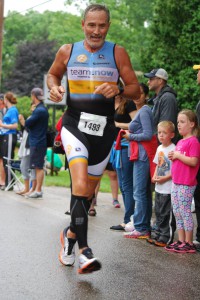 I didn’t see any Team OAM Now members until just before the turnaround. I saw one man coming towards me and I racked my brain to remember who it could be. I settled on Brian Reynolds. As I rounded the turnaround, a volunteer told me I was the second female. I saw Raquel Torres less than half a mile back. She had started two waves after me, so had made up ten minutes on me at that point. She passed me within the next mile and we exchanged a few words of encouragement. Next thing I knew, Kaitlyn Patterson, who started in the same wave as Raquel, flew past me. I was going a bit over 21 mph at the time, so knew she had to be going at least 24. I made a mental note to attempt to mountain bike more and see if it turned me into a beast on the bike like her! Kaitlyn hasn’t been doing a lot of triathlon training as she has spent the year racing mountain bikes, and yet, there she was, dominating a half-iron tri on the road! Not long after Kaitlyn passed me, I was passed by another Team OAM Now male, who I decided was probably Todd Anthes. At that point, I was out of water, my hip was completely cramped, and I was in too much pain to pay attention to people coming up on the other side. I missed a few teammates, but all I could think about was finishing at that point! I was passed by another woman in the aquabike, Kim Albin. She’s a strong cyclist and I tried to stay with her, but it wasn’t happening for me. (My heart said go, go, go, but my body said no, no, no – although I think the actual song has those two things in reverse…) My focus was then to just hold off the women behind me to preserve a podium place in the half aquabike. The finish line couldn’t come fast enough!
After the race, I immediately found an icepack for my hip and tried to waddle around awkwardly to find my friends and teammates. Overall, I had a decent race, although I would have liked to have been able to finish the bike as hard as I started. Regardless, Team OAM Now had a lot of podium places, and I was proud to be one of them despite my injury. Most notably, Team OAM Now had the top 2 females in the half iron distance! Kaitlyn, who remember, has been focusing on mountain bike training, won the half iron with a stellar time of 4:30! Raquel was second, pulling the awesome time of 4:38 in her first ever half. Brian went 4:10 in his first half, which was good for fourth overall and first in his age group. I think I’ll keep hanging out with these fast folks in the hope that some of their speed rubs off on me!
I didn’t see any Team OAM Now members until just before the turnaround. I saw one man coming towards me and I racked my brain to remember who it could be. I settled on Brian Reynolds. As I rounded the turnaround, a volunteer told me I was the second female. I saw Raquel Torres less than half a mile back. She had started two waves after me, so had made up ten minutes on me at that point. She passed me within the next mile and we exchanged a few words of encouragement. Next thing I knew, Kaitlyn Patterson, who started in the same wave as Raquel, flew past me. I was going a bit over 21 mph at the time, so knew she had to be going at least 24. I made a mental note to attempt to mountain bike more and see if it turned me into a beast on the bike like her! Kaitlyn hasn’t been doing a lot of triathlon training as she has spent the year racing mountain bikes, and yet, there she was, dominating a half-iron tri on the road! Not long after Kaitlyn passed me, I was passed by another Team OAM Now male, who I decided was probably Todd Anthes. At that point, I was out of water, my hip was completely cramped, and I was in too much pain to pay attention to people coming up on the other side. I missed a few teammates, but all I could think about was finishing at that point! I was passed by another woman in the aquabike, Kim Albin. She’s a strong cyclist and I tried to stay with her, but it wasn’t happening for me. (My heart said go, go, go, but my body said no, no, no – although I think the actual song has those two things in reverse…) My focus was then to just hold off the women behind me to preserve a podium place in the half aquabike. The finish line couldn’t come fast enough!
After the race, I immediately found an icepack for my hip and tried to waddle around awkwardly to find my friends and teammates. Overall, I had a decent race, although I would have liked to have been able to finish the bike as hard as I started. Regardless, Team OAM Now had a lot of podium places, and I was proud to be one of them despite my injury. Most notably, Team OAM Now had the top 2 females in the half iron distance! Kaitlyn, who remember, has been focusing on mountain bike training, won the half iron with a stellar time of 4:30! Raquel was second, pulling the awesome time of 4:38 in her first ever half. Brian went 4:10 in his first half, which was good for fourth overall and first in his age group. I think I’ll keep hanging out with these fast folks in the hope that some of their speed rubs off on me!
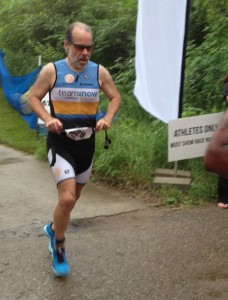 Sprint
Chuck Grzanka- 1st AG
Paul Raynes- 2nd AG
Sprint Relay
Mike Steele- 1st OA
Michelle Olson (Elite Club) 1st OA
Half Aquabike
Elaine Sheikh-3rd OA
Half
Kaitlyn Patterson- 1st OA
Raquel Torres- 2nd OA
Brian Reynolds- 1st AG, 4th OA
Todd Anthes- 3rd AG
Michelle Dalton- 9th AG
The post Soggy Socks Don’t Slow Down Team OAM Now at Grand Rapids Tri appeared first on Team Athletic Mentors.
Sprint
Chuck Grzanka- 1st AG
Paul Raynes- 2nd AG
Sprint Relay
Mike Steele- 1st OA
Michelle Olson (Elite Club) 1st OA
Half Aquabike
Elaine Sheikh-3rd OA
Half
Kaitlyn Patterson- 1st OA
Raquel Torres- 2nd OA
Brian Reynolds- 1st AG, 4th OA
Todd Anthes- 3rd AG
Michelle Dalton- 9th AG
The post Soggy Socks Don’t Slow Down Team OAM Now at Grand Rapids Tri appeared first on Team Athletic Mentors. 



 Our Hockey Site
Our Hockey Site Team AM
Team AM



